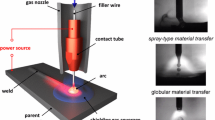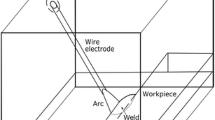Abstract
In the modeling of the gas metal-arc (GMA) welding process, heat inputs to the workpiece by the arc and the metal transfers have been considered separately. The heat energy delivered due to the metal transfer has been approximated in the form of a cylindrical volumetric heat source, whose dimensions of the radius and the height are dependent on the molten metal droplet characteristics. The pinch instability theory (PIT) and the static force balance theory (SFBT) of drop detachment have independently been used to obtain the expressions for various characteristics of the drop,i.e., the drop radius, the drop velocity, and the drop frequency at various welding parameters. The occurrence or the nonoccurrence of finger penetration, routinely found in the GMA welding at high welding currents, has been satisfactorily explained by the cylindrical heat source model. The effect of various welding parameters,e.g., the welding current, the wire radiusetc., on the weld bead penetration characteristics has been investigated. In this modeling effort, the heat conduction equation has been solved in three dimensions.
Similar content being viewed by others
References
The Physics of Welding, J.F. Lancaster, ed., Pergamon Press, New York, NY, 1984, pp. 204–64.
W.G. Essers and R. Walter:Weld. J., 1981, vol. 60 (2), pp. 37s-42s.
Z. Paley and P.D. Hibbert:Weld. J., 1975, vol. 54 (11), pp. 385s-392s.
J. Goldak, A. Chakravarti, and M. Bibby:Metall. Trans. B, 1984, vol. 15B, pp. 299–305.
P. Tekriwal and J. Mazumder:Weld. J., 1988, vol. 67 (7), pp. 150s-156s.
E. Pardo and D.C. Weckman:Metall. Trans. B, 1989, vol. 20B, pp. 937–47.
K.C. Tsao and C.S. Wu:Weld. J., 1988, vol. 67 (3), pp. 70s-75s.
Subodh Kumar and S.C. Bhaduri:Metall. Mater. Trans. B, 1994, vol. 25B, pp. 435–41.
J.H. Waszink and M.J. Piena:Weld. J., 1986, vol. 65 (11), pp. 289s-298s.
J.H. Waszink and L.H.J. Graat:Weld. J., 1983, vol. 62 (4), pp. 108s-116s.
Y.S. Kim and T.W. Eagar:Weld. J., 1993, vol. 72 (6), pp. 269s-278s.
H.S. Carslaw and J.C. Jaeger:Conduction of Heat in Solids, 2nd ed., Oxford University Press, London, 1959.
S.S. Rao:Finite Element Method in Engineering, Pergamon Press, Oxford, 1982, pp. 418–505.
E. Hinton and D.R.J. Owen:Finite Element Programming, Academic Press, New York, NY, 1977, pp. 140–206.
Physics Division, The National Physical Laboratory:J. Iron Steel Inst., 1946, vol. CLIV (2), pp. 83P-121P.
E.C. Lemmon:Numerical Methods in Heat Transfer, John Wiley, New York, NY, 1982, pp. 201–13.
K. Ishizaki:The Physics of Welding Arc, A Symp., The Welding Institute, London, 1966, pp. 195–209.
Author information
Authors and Affiliations
Rights and permissions
About this article
Cite this article
Kumar, S., Bhaduri, S.C. Theoretical investigation of penetration characteristics in gas metal-arc welding using finite element method. Metall Mater Trans B 26, 611–624 (1995). https://doi.org/10.1007/BF02653882
Received:
Issue Date:
DOI: https://doi.org/10.1007/BF02653882




